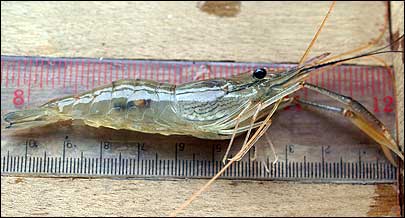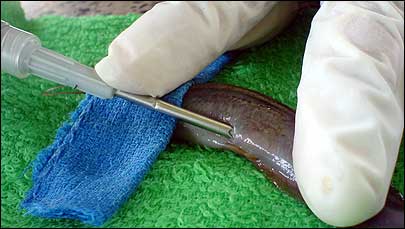Researchers in Thailand are investigating the benefits of radio frequency identification for tracking prawns and fish to monitor growth and improve breeding. According to project leader Rungtawan Panakulchaiwat, staff members with the department of fisheries science at King Mongkut’s Institute of Technology Ladkrabang have successfully embedded passive RFID tags in giant prawns, Nile tilapia and walking catfish. The team released preliminary results of trials examining the use of RFID to monitor broodstock—cultured species that are kept separate for breeding.
The three chosen species, which are grown on farms as food for humans, have an annual export value of 2 million baht ($59,500), Rungtawan says, and improving the breeding process could add significantly to the nation’s exports. Determining the exact breed and monitoring the growth of each animal in a broodstock, however, has proven difficult.
“The objectives of the project are to determine a suitable position for RFID tagging, and the effect of tagging on growth, survival rates, stress protein expression and histological change,” Rungtawan says. “This will determine if RFID can be used for broodstock management on farms.”
According to Rungtawan, the RFID tag needs to be embedded inside an animal’s body, and the project is studying the chip’s exact placement so the creature is not harmed in any way. Since last year, the team has embedded tags into more than 1,000 giant prawns, Nile tilapia and walking catfish. The tags measure 1 centimeter (0.4 inch) in length and are inserted into baby animals when they reach a length of 5.5 centimeters (2.2 inches).
After 12 months, Rungtawan says, preliminary findings appear to have determined the best position for inserting the tags, which is a sensitive process. “In Nile tilapia and walking catfish, we determined the suitable position [to embed an RFID tag] is the abdominal cavity,” she states. “We found that the RFID tags do not affect growth or survival rate. Histological examinations showed complete recovery in 21 days. We are continuing to study the effect on stress-protein expression, and the effect on giant prawn, and expect to conclude the project in six months.”
Thailand RFID providers Silicon Craft Technology and IE Technology have provided the RFID chips, readers and software for the deployment. Developing the technology was challenging, says Shan Sharma, Silicon Craft Technology’s international business development manager, as there was little knowledge available regarding RFID implantation in aquatic species.
“We provided the 10-millimeter glass transponders and handheld readers to work with their own software to automate data matching between the fish identification and weight recorded from digital weight scales,” Sharma says. The tags operate at a frequency of 134.2 kHz and comply with the ISO 11784 and ISO 11785 standards.
An animal is identified by means of a tag’s unique serial number, which is stored in a database, along with other information, such as the animal’s breed, growth and diet. Growth is tracked monthly to monitor the animal’s overall development, and the software helps researchers analyze the data. If the tags identify that an animal is not growing well, researchers can implement crossbreeding to improve the species.
“The study has provided valuable information on the level of injury, healing of fish tissue at the injection area, stress levels and growth rate after injection,” Sharma states. “Now we know where the best place is for injection, and can recommend the implanting of glass tags in commercial farming.”
The project has received 3 million baht ($89,000) in funding from the National Electronics and Computer Technology Center (Nectec), a research and development agency operating under Thailand’s Ministry of Science and Technology that aims to promote the RFID industry in that country.
Nectec spokesman Chaichana Mitrpant says the organization provided the funding because the project would deliver a guideline for employing RFID for small aquatic animals with scientifically verified technology. In addition to investigating the physical effects of implanting RFID tags in aquatic animals, he says, the project will also develop a prototype broodstock farm management system.
“We believe this project is crucial to creating awareness and user acceptance for adopting new technology,” he says. “After completion of the project, the broodstock farm management system could be used by local private companies. The knowledge from this research project could be used in medium- to large-size broodstock farms and make developing new breeds easier.”
Nectec believes the experiments need to be repeated in order to gain more confidence in the statistics of survival and recovery rates. But once the tests are completed by mid-2009, he says, the center intends to promote the technology and share knowledge with private aquatic animal farms. The project could also help further develop RFID technology in Thailand for use in other operations, such as logistics and food tracking.




